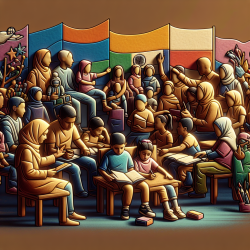Introduction
In the face of displacement and conflict, children are often the most vulnerable. The research article "Resilience and adjustment trajectories amongst children in displacement-affected communities in Zarqa, Jordan" provides critical insights into how these children adapt and what factors influence their well-being. As practitioners in the field of speech language pathology, understanding these dynamics is crucial for tailoring interventions that foster resilience and support developmental progress.
Key Findings from the Research
The study followed Syrian refugee and Jordanian children over a fifteen-month period, assessing various outcomes including protection concerns, caregiver stress, mental health, and developmental assets. Notably, the research highlighted:
- Improvement in child protection concerns and mental health symptoms over time.
- Constant levels of caregiver stress and a decline in developmental assets.
- Significant positive impacts of school attendance on protection concerns, caregiver stress, and developmental assets.
- Concerns over lost livelihoods significantly predicted higher protection concerns and caregiver stress.
Implications for Practitioners
For practitioners in speech language pathology, these findings underscore the importance of integrating educational support and addressing socio-economic factors in therapeutic interventions. Here are some actionable steps:
- Focus on Educational Engagement: Encourage school attendance and engagement in educational activities as they are linked to better outcomes in protection concerns and developmental assets.
- Address Socio-Economic Stressors: Collaborate with community organizations to provide resources that alleviate caregiver stress related to economic instability, which can indirectly benefit children's mental health and development.
- Holistic Approach: Incorporate resilience-building strategies in therapy sessions that not only focus on speech and language but also on emotional and social skills, fostering a supportive environment for children to thrive.
Encouraging Further Research
While the study provides valuable insights, it also opens avenues for further research. Practitioners are encouraged to explore:
- The long-term impact of educational interventions on speech and language development in displaced children.
- The role of community-based programs in enhancing resilience and reducing socio-economic stressors.
- Innovative therapeutic approaches that integrate cultural and contextual factors specific to displaced populations.
Conclusion
Understanding and addressing the unique challenges faced by displaced children is vital for their developmental success. By leveraging the insights from this study, practitioners can enhance their interventions, ultimately leading to better outcomes for these vulnerable populations. To read the original research paper, please follow this link: Resilience and adjustment trajectories amongst children in displacement-affected communities in Zarqa, Jordan.










